Japan Wood Products
Prices
Dollar Exchange Rates of
12th April 2013
Japan Yen
98.41
Reports From Japan
February housing starts better than forecast
Housing starts in Japan increased at a slower pace in February, marking the
fourth month of reduced growth. Housing starts rose 3.0 percent in February
2013 compared to levels in the same month in 2012.
Despite the decline in the pace of growth February figures were better than
the expected 2% decline but worse than the 5.0% year on year rise in housing
starts reported in January this year.
The better than expected numbers were the result of improved consumer
sentiment, low interest rates and firm demand as home owners try to beat the
planned sales tax increase due some time next year.
Major house builders reported that orders in February rose over 16% compared
to February 2012.
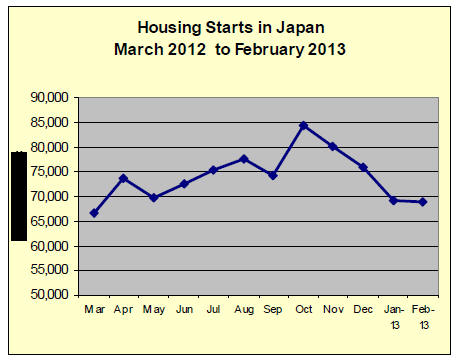
For the complete housing data see the Construction Research and
Statistics Office Policy Bureau, Ministry of Land, Infrastructure, Transport
and Tourism website at:
http://www.mlit.go.jp/toukeijouhou/chojou/stat-e.htm
Yen continues its slide against major currencies
On 8 April the yen fell to 99 to the US dollar, its lowest in almost four
years. The steep drop in the value of the yen surprised markets and was
driven by an immediate buying spree by the Bank of Japan (BoJ), sweeping up
debt issued by the government.
The BoJ began its debt buying on 8 April, purchasing almost US$16 billion in
its first phase of its stimulus plan. This move by the BoJ will ensure that
borrowing costs remain low.
The yen fell to new lows against major currencies in the first week of April
almost testing the 100 yen to the US dollar mark.

However, every fall in the value of the yen pushes up the cost of
imported fuel and this poses a risk to domestic demand as almost all fuel is
imported. Almost all nuclear power plants in Japan have been shut down for
safety checks after the recent disaster.
When the yen 100 level is crossed analysts expect profit taking which could
slow the depreciation of the yen but probably not for long.
For a sustained weakening of the yen there would need to be decisive moves
by Japanese institutional investors to start buying higher-yielding assets.
A suggestion that this has begun is the yield on some European bonds which
have fallen.
Business sentiment improves but less than expected
The Bank of Japan (BoJ) released its first quarter 2013 Tankan survey on 1
April.
The Tankan is an economic survey of Japanese businesses used by the BoJ to
decide monetary policy. The survey results are issued four times a year in
April, July, October and mid-December.
The survey reports views on prospects derived from around 10,000 companies
with a specified minimum amount of capital, although firms deemed
sufficiently influential may also be included.
The companies are asked about current business trends and conditions as well
as their views on future investment and sales.
Overall, business sentiment improved in the January to March quarter but the
improvement was less than expected, highlighting the challenge facing the
Japanese government as they try to revive economic growth.
The index for big manufacturers remains negative but improved from minus 12
in December to minus 8 in the latest survey. A negative figure indicates
that private sector pessimists outnumber optimists.
Analysts had forecast a substantial improvement in business sentiment
amongst the large manufacturers anticipating an index improvement to -1 for
the Jan-Mar quarter but the latest data suggest that even in the second
quarter the pessimists will outnumber the optimists.

Weaker yena boost to exporters
The new government and the central bank have taken various steps to try and
revive domestic demand and weaken the yen. Analysts say these moves helped
improve company profit outlook for large sized businesses and boost
sentiment.
This is the first survey since the government and BoJ adopted aggressive
policies to lift the economy out of recession. While these moves have helped
business sentiment and the weaker yen is providing a boost to exporters
business remain cautious.
The survey reports that large firms plan to reduce capital investment in the
current financial year and this is interpreted by analysts as suggesting
business leaders are yet to be convinced that domestic demand will improve
or that the risk of external shocks has diminished.
Small companies yet to feel benefit of stimulus measures
For small manufacturers sentiment remains very negative. The small companies
included in the survey anticipate an even larger reduction in capital
investment than the larger companies.
The slow pace of improvement in business conditions in the private sector
reflects fears that the economic stimulus measures being proposed by the
government and BoJ will be slow to arrive. Adding to the concerns of
businesses is the unsettled global economic outlook and the continuing stain
in Sino-Japanese relations.
The disappointing results of the Jan-Mar 2013 Tankan influenced the bold and
unprecedented moves by the BoJ which, at its last meeting, announced further
wide ranging monetary easing measures.
If pessimism dominates the next Tankan it will be very difficult for the BoJ
to achieve the 2 percent inflation target it has set as succeeding with this
would require companies to increase investment and wage levels.
Many analysts, including the previous BoJ governor say that stimulus
measures alone will not end 15 years of deflation and that structural reform
and deregulation must be addressed also.
Trade news from the Japan Lumber Reports (JLR)
The Japan Lumber Reports (JLR), a subscription trade journal published every
two weeks in English, is generously allowing the ITTO Tropical Timber Market
Report to extract and reproduce news on the Japanese market.
The JLR requires that ITTO reproduces newsworthy text exactly as it appears
in their publication.
For the JLR report please see:
http://www.n-mokuzai.com/modules/general/index.php?id=7
Plywood supply in February
Total supply of plywood in February was 494,200 cubic metres, 3.1% more than
the same month a year ago and 7.3% less than January. This is the first time
that the supply dropped below 500,000 cubic metres in five months. This is
due to decline of imported plywood by about 40,000 cubic metres.
Imported plywood in February was 284,200 cubic metres, 2.0% more than
February last year and 12.5% less than January. In particular, the volume
from China dropped by 25,500 cubic metres from January, 32.1% less than
January because of delayed shipments by Chinese New Year holidays.
Average monthly import volume for last twelve months is 293,300 cubic metres.
Decline of import from Malaysia and Indonesia is result of log shortage in
rainy season.
Plywood suppliers in both countries reduce offer volume and meantime
Japanese buyers reduce purchase volume due to high offer prices.
Domestic production in February was 215,000 cubic metres, 4.6% more than
February last year and 0.6% more than January, out of which softwood plywood
was 197,200 cubic metres, 5.0% more and 1.0% more.
Monthly production volume exceeded 190,000 cubic metres for six consecutive
months. The shipment of softwood plywood was 204,900 cubic metres, 30% more
and 6.9% less.
The monthly shipment volume exceeded 200,000 cubic metres for five straight
months. The inventories are 127,600 cubic metres, 7,600 cubic metres less
than the inventories at the end of January. This is the lowest since October
2011.
Domestic made softwood plywood has been moving well despite demand slow
winter months so dealers had been making speculative purchase since late
December but it finally simmered down in late March. Until the inventories
dealers carry are digested, there won’t be much active purchase but total
inventory level remains low.
At the end of February, the softwood plywood inventories were 127,600 cubic
metres, lower than monthly consumption of about 200,000 cubic metres and
this is the lowest since October 2011 so the supply and demand balance will
be held for some time.
The manufacturers eased stiff sales policy after speculative purchase was
over. Current prices of JAS 12 mm 3x6 are 890-900 yen per sheet delivered,
40 yen up from March.1,790 yen on 24 mm 3x6, 90 yen up and 1,300-1,330 yen
on 9 mm 3x10, 50-80 yen up.
On imported plywood, speculative purchases were over and the market prices
stay in high level. The prices shot up sharply since late January by rapid
depreciation of the yen then the suppliers’ export prices also climbed
because of log shortage and high log cost.
This induced speculative purchases by the dealers then delayed arrivals in
late March eased tightness of supply.
The market prices in Tokyo region are 1,080-1,100 yen on 3x6 JAS concrete
forming, 30-100 yen up from March. 1,180-1,200 yen on JAS coated concrete
forming, unchanged from March. 1,100 yen on structural 12 mm 3x6, same as
March.
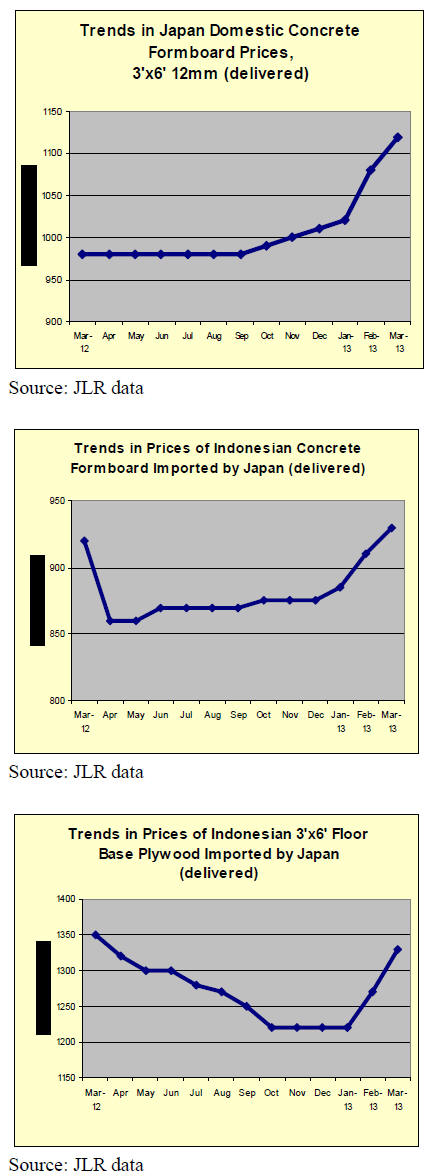
House builders flush with orders
Major house builders have ample orders in February. Low mortgage interest
rate, recovery of stock market and gradual rise of property prices seem to
stimulate housing demand. More people are visiting house exhibition sites
and people think this is time to buy house.
This is nothing to do with consumption tax increase in April next year so as
long as economic recovery continues, housing demand seems to stay active
even after the tax is raised.
 
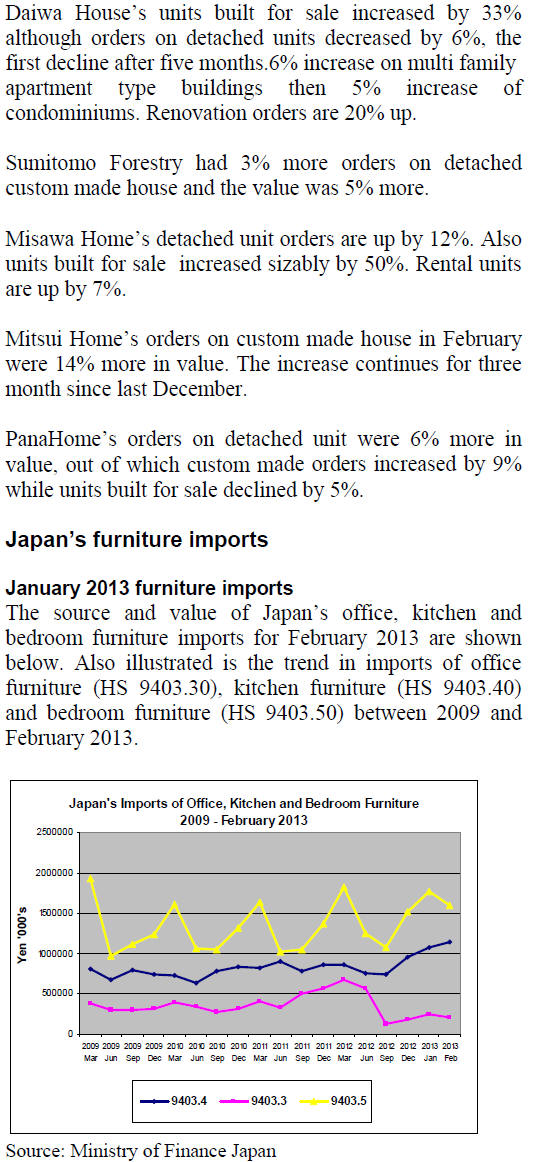
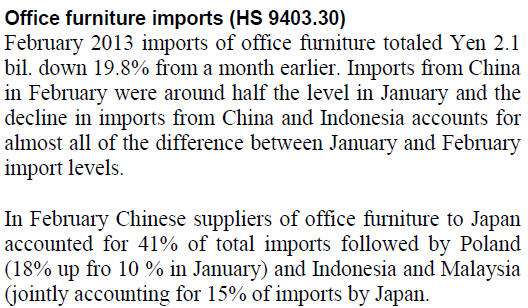


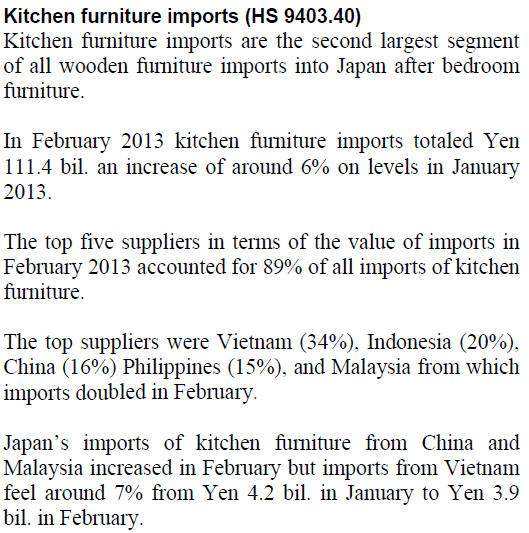
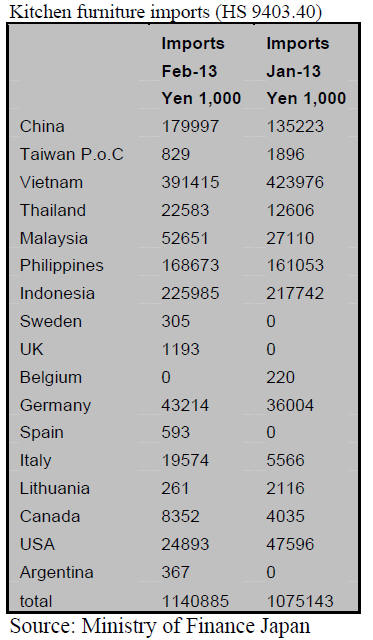

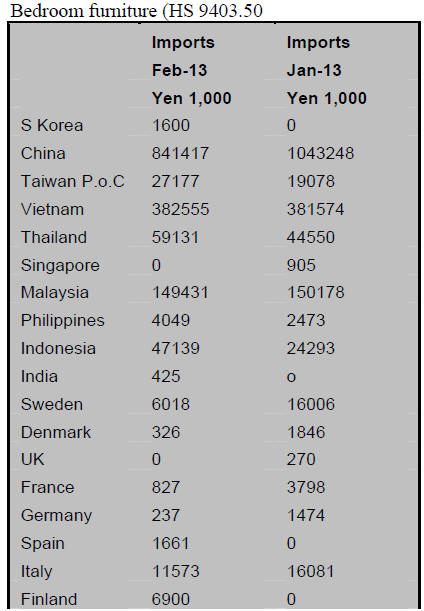 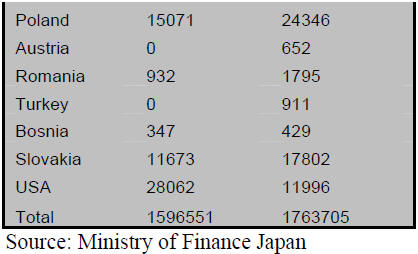
|